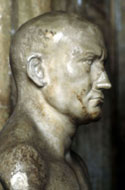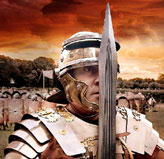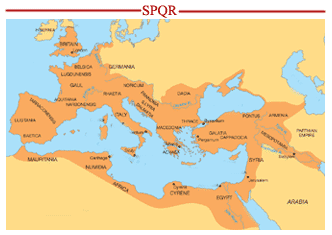Military Resource

Warfare,
Warriors & Empires.
| Ancient Military | ||
|
Ancient Empires
|
||
 |
||
|
Scipio Africanus
(235–183 BC) Roman Military Leader & Statesmen Known as one of histories greatest generals. |
||
The Roman Military |
 |
 |
||
| The Roman military was the most successful and powerful in history, dominating the Western world for over a thousand years. The size, strength and organization of their infantry force wouldn’t be equaled again for another thousand years. The Romans believed themselves to be descendents of Mars, literally the sons of the war god. They were a proud and uncompromising people who above all else excelled at the art of warfare. The core of Rome’s military strength lay in the professionalism of their heavy infantry. A force that was organized and reorganized as it evolved and adapted to survive the assaults of its mortal enemies, and conquer the Western world. What had started as a regional force of citizen soldier farmers evolved into a massive full time professional army, the world’s first. They became the supreme predator of their day, unmatched in battle and relentless in conquest. From their unremarkable origins the brutal Roman military conquered the Mediterranean world from Mesopotamia to Scotland until finally being absorbed and defeated by waves of barbarian invasions and internal decay. They were, perhaps, victims of their own success, having grown to large. It was a remarkable run though, spanning from their founding traditionally placed at 753BC until the last western Roman emperor was deposed in 486AD. Their success was made possible through both ruthless military might and a focused, determined population. |
||||
| Julius Caesar (100– 44 BC) Roman Military Leader and Dictator |
The Roman Milirary |
|||
 |
||||
|
The Roman Empire
Maximum extent of the ancient Roman Empire under Trajan in AD 117 |
||||
The Ancient Military of RomeBirth and Organization of the Roman MIlitary The Roman military was reorganized periodically throughout it’s existents in an effort to stay one step ahead of its opponents, but just as often for getting caught up a step. Regardless, they adapted to new threats quickly, becoming proficient enough in areas were they lacked to wear down their enemies. The Romans were originally a tribal group of three tribes. Little is know about this early period, all records were destroyed by a Celtic invasion in 483 BC. These early Romans would have probably fought as skirmishing light infantry armed with javelins, slings and possibly some bows. During the 7th century BC they came to be dominated by the Etruscans, their more advanced northern neighbors. Etruscan kings would rule Rome for 200 years as military dictators. Around 510 BC the Romans expelled the kings and set up a new republic government. They copied the Etruscans hoplite tactics, who had learned them from the Greeks and organized annual armies of citizen soldiers. Men were required to equip themselves and were organized by how much equipment they could afford. Rome’s nobles became cavalry and their poorest became skirmishers. The majority of Romans were formed into spear, shield and possibly helmet equipped infantry units, depending on what they could afford. This was the birth of the legions, farmer soldiers fighting for their families and territory. Duty was mandatory, something the honor driven early Romans didn’t need to be told though. In 483 BC, a Gaelic warlord and chieftain named Brennus invaded the newly formed republic. The entire Roman army was wiped out and the city sacked. The Etruscans had left Rome with poor defenses and the surviving citizens barricaded themselves on the Capitoline Hill. Tradition says the decimated and humiliated Romans were forced to pay Brennus and his Celtic warriors 1,000 pounds of gold to leave the city. However, the counterweights Brennus used on the scales were heavier then 1,000 pounds causing the Romans to complain. To this Brennus replied, "vae victis" meaning "woe to the vanquished", and threw his sword on top of the weights increasing the injustice. The insulted Romans had no recourse, and were forced to provide even more gold. The humiliated Romans had been taught a lesson they would never forget. The memory of this event fueled their militarism as they vowed to never let it happen again at any cost. Rome would become a hardened society, brutality and violence would become a hallmark of their uncompromising military. They also learned practical military information from their run in with the celtic Gauls. The Gauls used more advanced iron-working techniques and specialized in close-quarter combat. The Gauls employed heavy long sword and full body shields. These shields could be used to form what the Romans called a “tortoise” when employed in close formation and provided an excellent defense. The differences were noted and the roman military was revamped. Another lesson learned was that Rome’s defenses where highly insufficient. The Roman’s constructed a formidable defensive wall and would be known throughout their history for their fortifications and engineering. Another bitter lesson surrounded their loss of their leaders and aristocratic sons at the hands of the Gauls. The top of Roman society were the best equipped warriors and formed the first rank of their hoplite (shield wall and spear) formations. They moved to a three lined strategy with their fist class soldiers forming the last battle line, the Triarii. The early Romans were served well using citizens, mostly farmers, as hoplite soldiers and they gained supremacy over the neighboring farming regions, the Latins, who also used hoplite tactics. However, when they came into conflict with the hill tribes on their Southwest border they quickly learned the limitations of shield wall formations. In a grueling fifty year long conflict, fought over three wars the Romans sought to bring the herdsmen to heal. The herdsmen warriors that dominated the central hills and mountains of Italy were the formidable Samnites who had spilled out of the mountain valleys and defeated the coastal Greek settlements along the shin of Italy. The Samnite Wars (340 BC -290 BC) pitted two different styles of warfare against each other. The confederation of hill tribes where more lightly armored, having perhaps only a small shield. Their main weapons were javelins, each soldier launching them from a loose formation. The Romans were using a phalanx tactic, where forces of spearmen lock shields to form a wall. The left of each shield protecting the soldier on the left, and the spears of the first two to three rows stick out. A phalanx presented a formidable wall of spear tips towards the front but was vulnerable from the sides and rear. Further more, if the units cohesion broke down and gaps formed in the line the vulnerable flanks of soldiers would be exposed. The Samnites exploited both of these weaknesses in the rugged hill country of Samnium dealing the Romans some stinging defeats. However the Romans tenacity showed through, they dumped the phalanx formation that had made them a regional power and switched to the formation of the Samnites. The new system, called the maniple system arrayed the legionnaires in a checker board fashion. Squares of about 120 men formed the basic unit, a maniple. Skirmishers could then fall back through the gaps in the checker board formation. The first two rows of maniples would form a single line when confronting enemy heavy infantry. The Roman army was organized so that three of these battle lines could be formed to face the enemy. The front two maniple rows, the first battle line, were made of raw recruits called hastati, who would absorb charges and battle the enemy until exhausted. They then could retire through the gaps in the maniples behind them. The next two rows of maniples, the principes, would then face the enemy fresh for the battle, these were the experienced warriors and they were expected to finish off their tired and battered opponents. However, if this line fails the final two rows of maniples, the Triarii, would then form the final line of defense. These would be the battle hardened veterans, and their deployment meant the situation had become desperate. Another advantage the maniple system offered was its flexibility. A single maniple could be pealed off an army to cover a flank or take a ridge. It also was much easier to maintain on rough ground. The Roman weapons also changed, arming the first Hastati and Principes with short thrusting swords and only the Triarii with spears. Legionaries were also given two javelins, called pila, another adaptation from the Samnites. Faced with the larger population of Rome and no military advantage, the lands of Samnium where colonized and their military ground down. The Samnites lost their freedom, forced under direct roman rule. After securing victory the Romans consolidated their hold over Italy bringing them into conflict with Pyrrhus of Epirus and Macedonia, a leading general in the Hellenistic (Greek) world. The Pyrrhic War (280–275 BC) was a complex struggle for control of Italy and Sicily involving the western Greek cities, Pyrrhus, Italian peoples (Etruscans and Samnites), Carthaginians and the Romans. The phalanx formation used by Phyrus was developed by Phillip of Macedonia and used by Alexander the Great to conquer the known world. Spear lengths had been doubled presenting an almost impenetrable wall of spear heads. Although their shields had to be reduced to allow hoplites to use two hands to hold the longer spears this formation had become dominate in the Hellenistic world. Pyrrhus also brought war elephants to Italy, something the Romans had never faced. In several bloody battles Pyrrhus scored narrow victories against the roman legions but the heavy losses caused him to with draw from Italy. After one such bloody battle Pyrrhus is said to have stated, "If we are victorious in one more battle with the Romans, we shall be utterly ruined." The Romans learned to defeat the elephants by using their pila. Once the elephants had been hit by the projectiles they would become enraged and uncontrollable. This made them just as likely to trample their own troops as the enemies in their rampage. More importantly though, the Romans had faced the Macedonian phalanx and fought it to a draw, showing they could go toe to toe with the worlds best heavy infantry. Although their casualties were high the Romans were able to consolidate their control over Italy. The Latin cities of Rome provided their own heavy infantry legions to the Roman armies, although slightly inferior to the Roman legionaries. Also, the Romans used auxiliary troops, non-Romans who filled roles that the heavy infantry focused Roman military could not fill effectively, such as archers, light skirmishers and cavalry. In the Second Punic War (218 BC to 201 BC) the strength of the Italians union became critical. Rome and Carthage grappled again, this time for all of the Western Mediterranean. Hannibal, the great Carthaginian general had crossed into Italy over the Alps. After crushing the Romans in multiple battles and inflicting devastating amounts of casualties he began a strategy of attempting to coax the Italian allies to turn on Rome. For 17 years he ravaged Italy before being recalled to the defense of the city of Carthage. Hannibal’s success was in that he used the Romans strength against them. He continual out thought the Romans who always confidently marched into battles. The Romans, certain of their superiority in head to head battles were easily led into his carefully planned traps. It took the annihilation of three Roman armies, over 100 thousand of Rome’s sons and much of the Roman leadership before the new strategies were tried. First Fabious earned his moniker of Fabious the Delayer by avoiding pitched battles with Hannibal until it was in a spot of his choosing. Later Scipio Africanus was able to beat Hannibal at his own game, turning some Carthaginian allies against them. Scipio defeated Hannibal and rome learned a valuable lesson about strategy, improving their Generals cunning. Scipio also introduced a deadly new short sword that he had come across in the Spanish theatre of the war, the gladius. Crafted by Celtic, Iberian and Celtiberian tribes these swords were the best in the world and would become the main weapon of the legions. Rome also took away the much greater prize, control of the Western Mediterranean. The Roman military that came out of the war would take over the entire Mediterranean world over the next two hundred years. First they proved they could defeat the Macedonian Phalanx by conquering Macedonia itself. Then the remaining Hellenistic kingdoms fell one after another. The only real threat to Rome emerged in the old nightmare of massive barbarian invasions. Around 113 BC, two tribes, the Cimbri and the Teutons who were of either Celtic or Germanic origins, invaded Rome and destroyed two Roman armies. Marius, Rome’s leading general, was granted authority to reorganize the army to face this dire threat. He dropped the land requirements for army recruits. This meant that the state would provide the arms and equipment, since the landless classes couldn’t afford the expense. The early legions originated from the citizen army of the Republic and consisted of farmer soldiers who were expected to own land. These land requirements had been dropping since the Punic Wars as fewer citizens owned land. The Romans own success was to blame, slaves taken in their victorious war against Carthage, Celtic tribes and in other conflicts were pouring into Rome by the hundreds of thousands and being used as agricultural workers. Large landowners used them on their lands and the new lands conquered by the Romans, which happened to go to the large landowners as well. The unemployed Roman farm laborers and sons of sold out farmers were recruited as the aristocracy decided to let the newly formed unemployed masses shoulder the military grunt work. Marius turned the army into a professionally structured organization. Although the legions were still largely filled by citizens, the citizens now would serve continuously for twenty years before being discharged and awarded a plot of land. Once Marius had standardized the Roman Legions arms and equipment he then standardized the battle lines, doing away with the old structure of the newest recruits attacking first only to be rescued by the drama of the veterans coming in to save the day. After Marius all maniples would be standardized. Veterans and new recruits would be mixed together as well as Romans and other Italians. Roman armies had always been followed by supply trains, wagons that trailed for miles behind the army. Lately however the army followers had swelled to ridiculous proportions, slowing the army down. Marius had his soldiers carry most of their own supplies, around 70 pounds worth of arms, equipment and supplies. The legionaries were derisively referred to as Marius’ Mules. Marius also marched his new army around Italy, building their endurance and strength for their coming showdown with the vast barbarian invaders. When the Cimbri and the Teutons invaded again, Marius and his legions were ready. The endurance of the Roman soldiers in battle was unmatched anywhere in the world. Marius also rotated the battle lines more frequently, putting fresh troops into the battle, not waiting for a battle line to be beaten before sending another in. Like a hockey couch, Marius rotated his lines, putting continual pressure on the enemies. After the barbarians initial wild, powerful charge was absorbed the legions could get down to the business of wearing them down. The Cimbri and Teutons were defeated and slaughtered. This was the form of the Roman armies of Caesar, Augustus and Emperor Titus. They conquered their old enemy, the Gauls in France and the Celts of Britain. In the East they took over the old Hellenistic Kingdoms, Syria, Egypt and Judea. When the ambitions of Rome’s great generals turned the Legions against each other in the civil wars that ended the republic and started the empire, it was in this form the legions battled. They where the supreme fighting force for 300 years after the reforms of Marius. Eventually barbarian nations, such as the Goths, learned new mounted tactics from the nomadic steppe tribes. The many barbarian tribes that surrounded the Empire had been in close contact with Rome on every level of society for centuries, and had also learned much of Rome and its military. The legions, after losing several battles at the hands of cavalry heavy barbarian armies reformed itself one last time. Since the early Republic the Romans used auxiliary troops, non-Romans who served with the legions in roles that the heavy infantry centric Roman military could not fill effectively. Light skirmish troops and heavy cavalry are two good examples. During the Empire these auxiliary troops steadily increased in numbers. By the late Empire they, along with foreign mercenaries, had became the core of Roman armies. Tribes such as the Goths became relied upon heavily and often needed to be bribed. After several bloody disputes with their mercenaries over pay Roman territory was invaded by the Huns, hordes of nomadic horse archers. This was followed by attacks by other barbarian groups such as the Lombards, Franks and Vandals. Even their old allies the Goths got in on the action. In the 5th century the last Roman Emperor of the Western Empire was deposed and Western Europe entered into the Dark Ages (although it wasn’t that dark of a time for the emerging barbarian nations). The empire created by the sword, perished by the sword. In the East the Roman Empire continued on for another thousand years as the Byzantine Empire. The Byzantine armies continued to develop the late roman military model. They made excellent use of cavalry, particularly mounted archers and were at times able to recover portions of the old Western Empire. The Byzantines remained a power until the fall of Constantinople, their great capitol city in 1453. What had been an unremarkable small town of cattle rustlers and farmers had used its stubborn and brutal military to create the greatest empire in western history. Many of their institutions, laws and customs continue as a foundation for modern society
|
||||